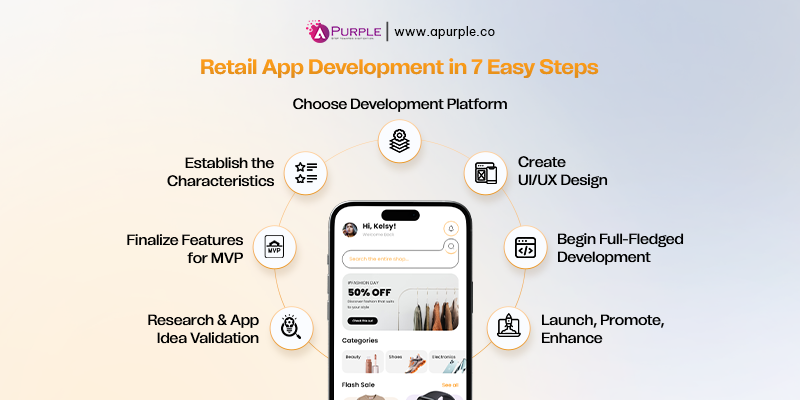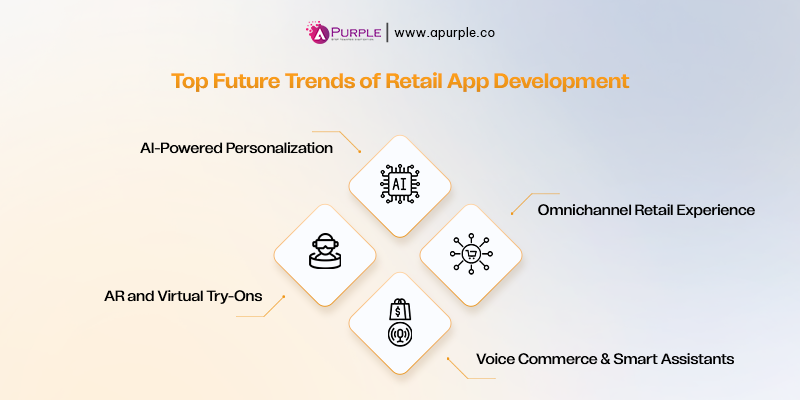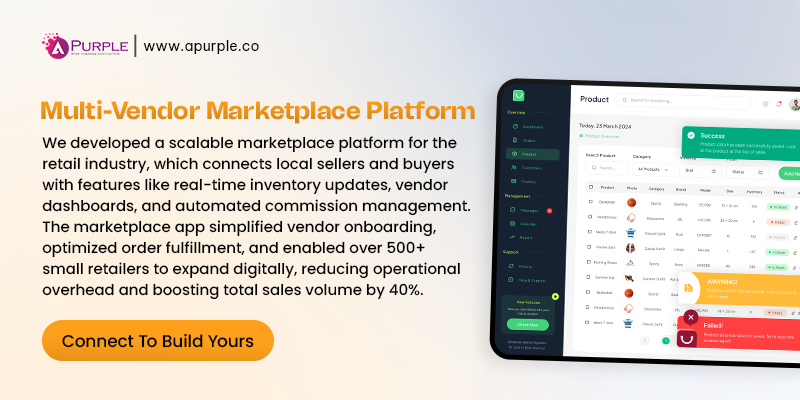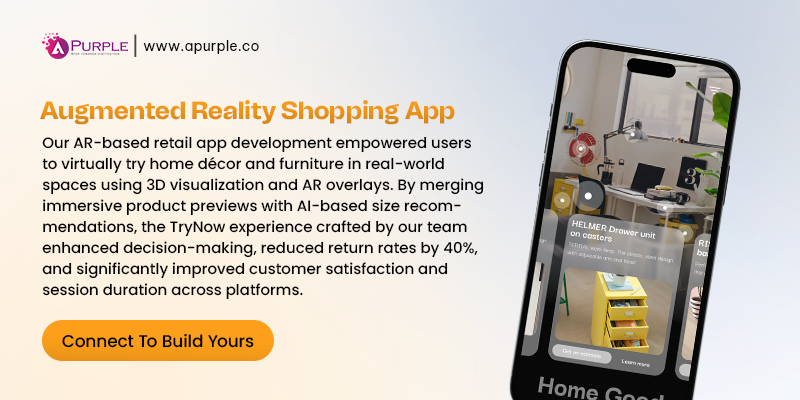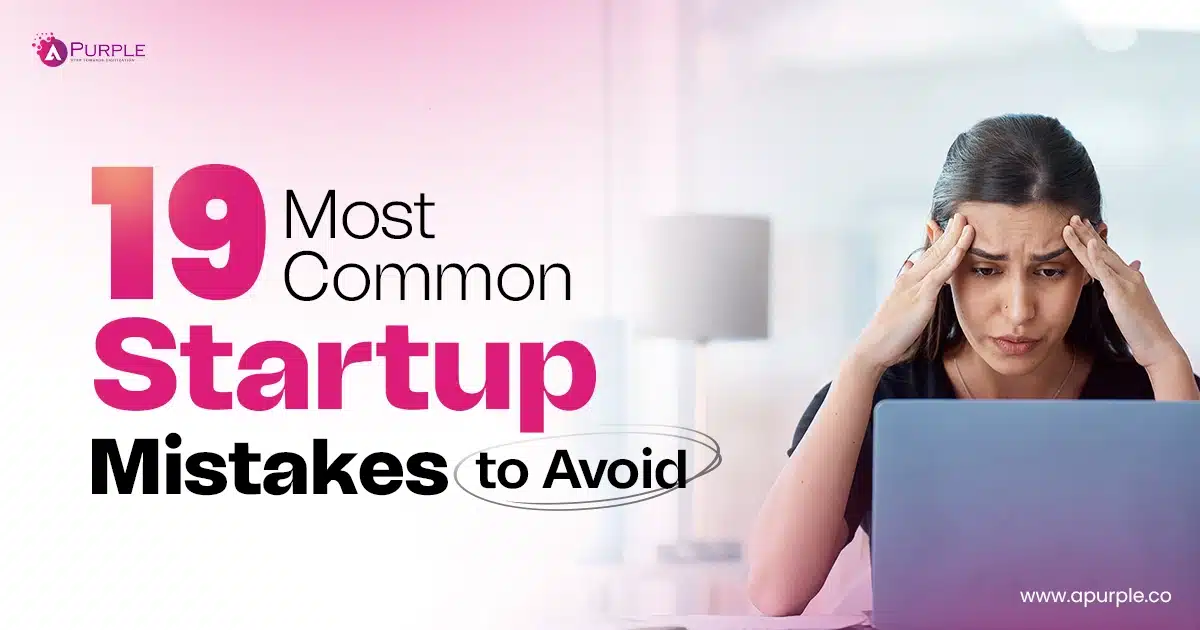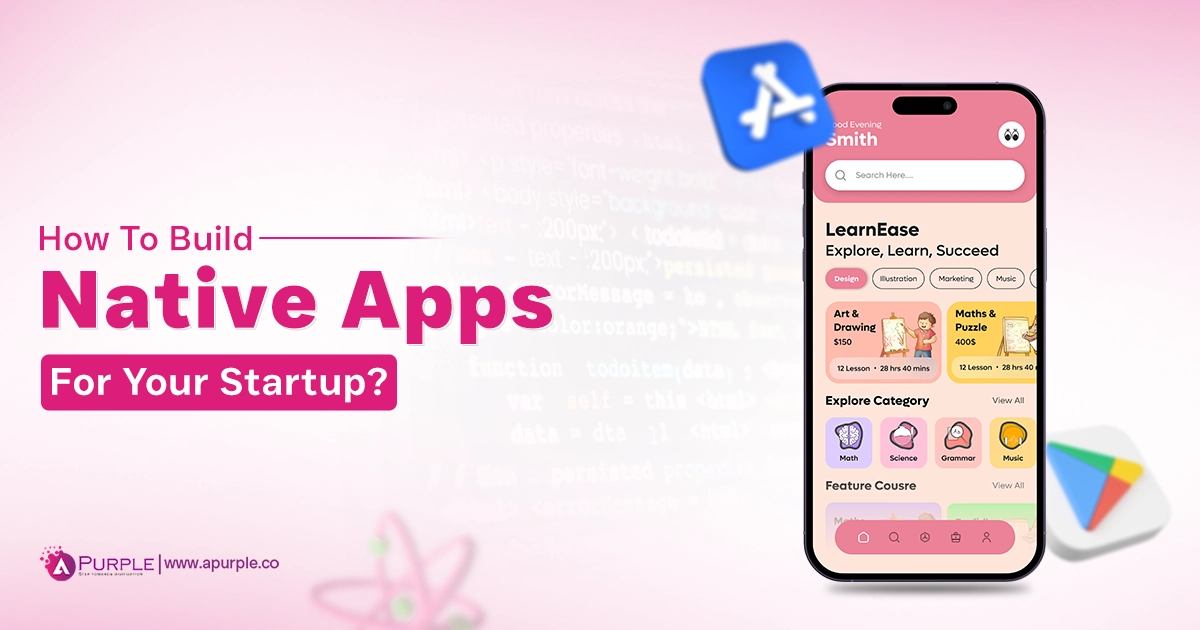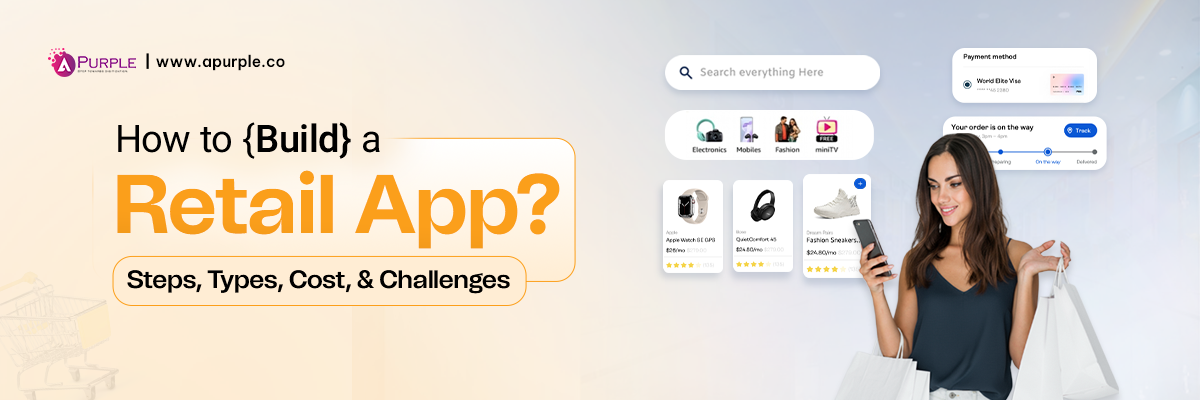
Whether you’re an ecommerce startup founder or a retail chain owner, building a retail app is no longer an option or upgrade: it’s a NECESSITY. Because while you’re contemplating whether retail app development is for you or if your startup can afford the cost of developing a retail app, your rivals are launching it and skipping way ahead of you.
At aPurple, we’ve helped over 100+ startup owners develop retail apps, integrate AI into retail apps, upgrade retail websites to apps, and so on to help them scale efficiently. We understand that building a retail app can feel complex and uncertain. That’s why we’re here to help you understand it so you can make an informed decision.
Gaining from our 10+ years of experience in developing retail apps, we have compiled this blog that outlines everything you need to know about retail app development. Right from different types of retail apps and best features to include in retail apps to steps to build a retail app and retail app development cost, it’s all in here for you to read and understand.
- What will retail app development really mean in 2026?
- How to avoid the most common mistakes in custom retail app development?
- Who is the best-rated provider of retail app development services?
What Is Retail App Development?
Retail app development is the process of creating a mobile app for retail businesses where customers can browse products, explore offers, make payments, and even track deliveries, all from their phones.
In simple terms, it’s about turning your physical store or online catalog into an experience customers can carry in their pocket. Retail app is a strategic business move that leverages technology and merges with customer psychology to get a high ROI.
What Are the Different Types of Retail Apps?
Types of retail app development can be categorized into multiple forms with their core functionality; each serves a specific business model and customer experience. Most popular retail app types include E-commerce apps, marketplace apps, loyalty and rewards apps, AR shopping apps, and social shopping apps. Let’s explore all these types of retail app development in detail and how startups are using them to scale faster and smarter.
1. E-commerce Apps
An e-commerce app development allows customers to browse, buy, and pay for products directly from their smartphones. This application offers smooth navigation, personalized deals, and multiple payment options to ensure a seamless shopping journey.
Popular Examples: Zara, Adidas
2. Loyalty and Rewards Apps
A Loyalty and reward app is created to encourage customer retention by providing points, cashback, or exclusive perks for repeat purchases. This type of retail app development helps startups build long-term relationships and increase brand loyalty.
Popular Examples: Starbucks Rewards, Sephora Beauty Insider
3. Marketplace Apps
Marketplace apps are developed to connect multiple sellers with buyers on one platform. Sellers earn commissions, manage listings, and provide secure payment gateway integration to streamline multi-vendor retail operations.
Popular Examples: Amazon, eBay
4. Augmented Reality (AR) Shopping Apps
AR shopping apps are developed to allow customers to visualize products in real-world settings just by using their phone camera. This way, it helps app users to reduce purchase hesitation and improve decision-making with immersive, interactive product previews.
Popular Examples: IKEA Place, Warby Parker
5. Social Shopping Apps
Social shopping apps combine commerce with social media, letting users discover, share, and buy products through influencer content, community reviews, or live-streamed sales events.
Popular Examples: Instagram Shopping
What Are the 7 Easy Steps of Retail App Development?
The retail app development process involves seven simple steps, which are curated from our popular guide on “how to create an app.” From market research & MVP development to product launch & business growth, we covered everything in these seven steps of successful app development for retail.
Step 1: Perform Market Research & Validate Your Retail App Idea
Planning an app development for retail businesses, then considering app idea validation, is the very first step for you. Conducting thorough market research is essential to ensure your idea is feasible and desirable.
But what are the answers you need from your retail market? Check this:
- Who are your real customers?
- What are the pain points of your target audience?
- What are their preferences and habits while shopping online?
- What problem are you trying to resolve whenever they shop online?
Finding Answers to the above questions helps you understand your customers deeply and find out what you need to build and target when you launch your retail app. Along with this, research how your competitors are leading the retail market by gathering answers to the following questions.
- Who are your biggest competitors?
- What features do they offer to your customers?
- What are their USPs?
- How do they market their retail app differently?
Our CEO, Paresh Sagar, has pointed out, “Every successful retail app starts with one question—not ‘what should we build?’ but ‘why would customers care?’ Market validation leads you to achieve growth strategies rather than watching dreams.”
For the retail app idea validation and performing data-driven market research, it’s always worth it to connect with a leading startup consulting services provider. They guide you from the beginning of your retail application development journey and drive you strategically to achieve what you dream of.
May You Want to Read: Top eCommerce Business Ideas for 2026 & Beyond
Step 2: Finalize Retail App Features for MVP Development
MVP refers to the Minimum Viable Product, which represents the core functionalities of your retail app.
But how do you know which features are the core of your retail app? For this, collaborating with MVP development services providers can make your work easy and success-proof. Based on our experience with retail and eCommerce clients, we help you give shape to your app’s purpose.
When you successfully establish your app’s purpose, you will finalize your MVP features. But first, you need to decide exactly what you want with your retail app idea:
- Starting an eCommerce business
- Want marketplace app development or something else?
Must-Have MVP Features for a Retail App:
- User registration & login (Email, phone, or social sign-in)
- Product catalog with search & filters
- Product details page (images, description, pricing, stock info)
- Secure checkout & payment gateway integration
- Order tracking & history
- Basic analytics dashboard (for admin to monitor sales & traffic)
With the MVP development of a retail app, you can validate your app idea with the real users’ feedback. Gather what your target audience says about your retail product and then make changes accordingly to achieve success seamlessly.
Step 3: Establish the Baseline Characteristics of Retail App Development
Baseline characteristics refer to the benchmarks that are responsible for forming the foundation of a new application. In the context of custom retail app development, some baseline characteristics could include:
- User Interface: Must be easy to navigate and have a visually appealing, user-friendly interface.
- Functionality: Core function performance must be effective.
- Security: The retail app must protect customer data and prevent fraud.
- Compatibility: Should be compatible with various devices and operating systems.
- Performance: The app must be optimized for speed and reliability.
If you take your baseline characteristics while developing retail and e-commerce app development, then it will lead to a maximum number of downloads, app retention, and customer satisfaction. The specific traits will depend on your app type, what the business goals and objectives of the apps are, and what the real needs and preferences of the target audience are.
Step 4: Choose the Right Platform to Develop a Retail App
You have to choose the right platform, which will also be determined from market research and proper consultation from your consulting or MVP development partner. Because the right platform decision defines how effectively your retail app reaches its target audience. Startups must research and consult regarding where their customers are most active: Android, iOS, or both.
If the budget and time are limited, opting for cross-platform or hybrid app development with frameworks like Flutter or React Native over native app development is a smart approach. This way, your app development cost is reduced by 40%, and app launch is accelerated.
Step 5: Create a User-Friendly UI/UX Design of Your Retail App
For designing a retail app, you can go with two approaches: one is Do-It-Yourself (DIY), or you can outsource retail app development and design services.
Most startups think a DIY approach is good to opt for, but in reality, it comes with its own set of drawbacks. One of the biggest drawbacks of doing design on your own is that you may not have the required set of expertise and experience in your team to create a retail app design. Instead, hiring a UI/UX designer is a profitable move that can bring many benefits.
By partnering with a design and development team that understands the importance of UX design and consists of a complete set of knowledge, skills, and expertise necessary for a retail app, you can deliver a solution that adds value to the customer’s life. The designs crafted by such teams are not just visually appealing but also match the mobile app design trends and are easily understandable to your customers for use.
Tip to Design and Develop Like a Pro:
Working with a retail app development services provider like aPurple, which can handle both UI/UX design and development, will save your time, money, and effort. Also, it leads to the best outcomes for your retail app without giving you any headaches.
Step 6: Start With a Full-Fledged Retail App Development Phase
Once your MVP product and design prototypes are validated, you have to move into the real build, the full-fledged retail app development phase. This is the step to craft a market-ready digital product.
Hiring an experienced mobile app development company can give you a team that focuses on creating a scalable architecture and integrating core retail features like product catalog, inventory sync, order tracking, & secure payments.
Make sure your development partner prefers the agile app development process for on-demand retail mobile app development. Ultimately, it saves months of iterations and ensures your solution is built to scale with future trends.
As you need your customer to return to your app again and again, don’t forget to add AI-powered personalization, data analytics dashboards, and push notification systems, which engage your users.
After this, prioritize robust testing cycles, performance optimization, and security compliance to make sure the on-demand retail app development handles real-world retail operations seamlessly.
Step 7: Launch, Promote, and Enhance Your Retail Solution
Full-fledged retail app development doesn’t mean you are free and your work is completed here. After proper testing, it’s time to launch your retail app, promote it, and keep the habit of monitoring its everyday performance.
This step is the stage to get the final payoff of your hard work. Check the following steps to launch, promote, and enhance your retail app.
a. Launch Your Retail App
For launching an app, you have to create a developer’s account for each app store, like the Apple App Store and Google Play Store, to make an app available to download.
An App Store submission requires an official developer membership account that costs $90 annually, and a Google Play Store submission needs a one-time fee of $25.
b. Promote Your Retail App
After making your apps available on app stores, you must focus on strategies of app store optimization (ASO). The proper optimization of an app’s description, title, keywords, and other elements helps in improving search rankings and visibility, which ultimately increases the number of app downloads.
Along with this, there are multiple channels to promote your app, such as paid advertising, social media, influencer marketing, email marketing, content marketing, etc.
c. Enhance Your Retail App Consistently
It’s good for you to successfully launch and promote a retail app, but after that, listening to your users and collecting feedback is crucial. Checking user reviews and ratings is crucial to determining an app’s performance and customer satisfaction.
You can use this feedback as the next step for your app, enhancements, updates, and new feature integrations. Continuous improvement in the app also enhances customer engagement and retention, which results in higher revenue and a great user experience.
What Are the Must-Have Features to Include in Retail App Development?
The core features of a retail app, such as personalization, seamless checkout, secure payments, and real-time inventory, are highly responsible for the app’s success. They deliver convenience, trust, and engagement within the app throughout the shopping experience.
- User Authentication: Enable secure login via email, phone, or social media for users to serve a personalized experience.
- Informative Product Catalog: Show organized product listings with images, prices, and descriptions to make browsing easy for users.
- Smart Search & Filters Option: Helps users quickly find products according to their preferred categories, brands, or keywords.
- Shopping Cart: Allows users to review, edit, and manage multiple selected items before doing final checkout.
- Secure Payment Gateway Integration: Allowing multiple payment options such as cards, wallets, and UPI ensures smooth and secure transactions.
- Push Notifications: Admin can send various offers, updates, and reminders to keep users engaged, informed, and coming back to the app.
- Order Tracking: Real-time updates on the product shipping and delivery status for better transparency between users and admin.
- Customer Reviews & Ratings: Builds trust and helps shoppers make informed purchase decisions on all the products they love.
- Wishlist & Favorites: Let users save products they love and intend to purchase later.
- In-App Chat Support: Provides 24/7 instant help for queries, improving customer satisfaction and retention.
How Much Does It Cost to Develop a Retail App?
The retail and eCommerce app development costs range from USD 10,000 to USD 150,000+, which depends on multiple factors.
Please note: The below-listed is an estimated cost and may vary depending on multiple factors such as features, platform, complexity, and development team location.
| Retail App Complexity | Estimated Cost | Timeline |
|---|---|---|
| MVP Development Cost | USD 10,000 to 14,000 | 8 to 12 Weeks |
| Basic App Cost | USD 12,000 to 28,000 | 12 to 14 Weeks |
| Medium Complexity App Cost | USD 28,000 to 40,000 | 14 to 16 Weeks |
| High Complexity App Cost | USD 40,000 to 65,000 | 16 to 18 Weeks |
| AI-Powered App Cost | USD 65,000 to 150,000+ | 18 to 22 Weeks |
What Are the Challenges Associated With Retail App Development? [+ Solutions]
The successful retail app development comes with many challenges, like unclear product vision, integration complexity, and scalability, that are mostly ignored by startups. Building a retail app isn’t just about coding; it’s about balancing user expectations, enhancements, and performance. Let’s uncover the top challenges startups face and how to solve them smartly.
| Challenges | How to Overcome It |
|---|---|
| Unclear Product Vision | Always prefer MVP development & validation as the first approach. Work according to feedback loops continuously to refine your product direction. |
| Integration Complexity | Use robust APIs and modular architecture to ensure smooth and scalable third-party integrations. |
| Scaling Too Fast, Too Soon | Optimize the backend at an early stage and adopt cloud infrastructure for retail app development to scale automatically with demand. |
What’s Next for Retail App Development? [Top Future Trends You Can’t Ignore]
The retail app development sector is growing faster with popular technology trends such as artificial intelligence, personalization, and so on. Here are the upcoming trends’ details that every startup should track before investing in their next-gen retail app.
1. AI-Powered Personalization
We must consider retail assistance when we talk about AI startup ideas. The AI-driven recommendation engines help retailers study and understand customer behavior deeply, predicting what they will go on to buy next.
From personalized deals to giving innovative product suggestions, AI-assistance boosts user engagement and sales with minimal human intervention.
2. AR and Virtual Try-Ons
Augmented reality technology that lets shoppers visualize products before even purchasing. Take the example of IKEA or Sephora; both use AR/VR tech, which allows users to try their products before final purchase.
This approach reduces returns, increases trust, and completely transforms the online browsing hurdles into an interactive, real-world experience.
3. Voice Commerce and Smart Assistants
Nowadays, voice-enabled shopping with the help of Alexa or Google Assistant is redefining convenience for online shoppers.
Integrating voice AI can make product discovery faster, improve accessibility, and elevate your retail app’s overall usability, ultimately contributing to higher revenue.
4. Omnichannel Retail Experience
The future of retail business isn’t sticking to only online or offline mode; it’s both. Apps will unify in-store, mobile, and web experiences, which will allow users to switch seamlessly between both modes while maintaining personalized journeys.
What Are The Real-World Examples of Successful Retail Apps?
Retail app success varies from region to region. From Amazon’s dominance to local champions like Shein and Lazada, let’s discuss region-wise popular examples with their key offerings.
| Retail App Name | Popular in the Countries | Top Features |
|---|---|---|
| Amazon |
|
|
| Shein |
|
|
| Temu |
|
|
| Walmart |
|
|
| Lazada |
|
|
| Mercado Livre |
|
|
aPurple – Retail App Case Studies
At aPurple, our team of experts has helped global retailers across the USA, UK, and UAE turn their app ideas into growth engines through cutting-edge retail app development. From loyalty-driven apps to immersive AR shopping experiences, we have mentioned a few success stories here that highlight our innovation and impact.
Final Thoughts On Efficient Retail App Development
The retail sector is no longer limited to running only storefronts; it’s thriving inside customer pockets. From AI-powered personalization to AR shopping experiences, today’s users expect innovation and convenience at every tap on their phone. A well-built retail app helps you meet those expectations while gaining a competitive edge in an increasingly digital marketplace.
Whether you’re a growing retailer or a visionary entrepreneur, the time to act is now. Partnering with an experienced eCommerce app development company like aPurple ensures your idea transforms into a scalable, engaging, and future-ready solution. The next big retail success story could be yours; it just needs the right app and the very right development partner to make it happen.
Frequently Asked Questions (FAQs)


